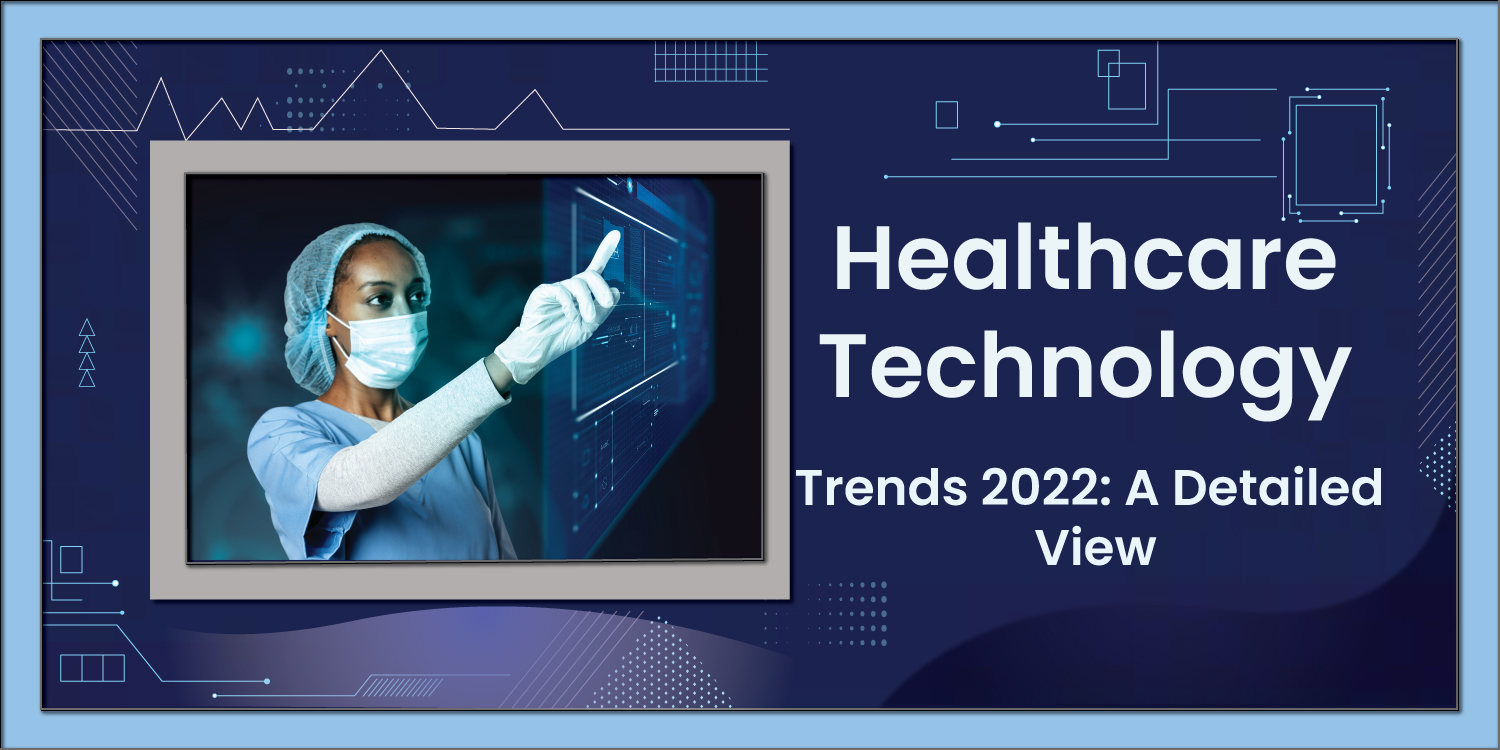Healthcare Technology Trends 2024: A Detailed View
The COVID-19 Pandemic has changed the healthcare sector globally in terms of dealing with telemedicine solution for patients and new diseases. Surely, the past couple of years has been a learning experience for all healthcare businesses and organizations. The digital solution development companies that design and deliver technological solutions to the healthcare sector have significantly changed their way of operation and included the healthcare technology trends in 2024 for better results.
The current market of Healthcare digital solutions is witnessing an immense change in the functionality and features of the new apps, software, or devices that are being developed taking everything into account.
Trends in digital healthcare in 2024 have revolutionized the sector with some positive changes. Let’s discuss new medical technology in 2022. But first, let’s take a look at the market overview of the healthcare sector and the projections for growth.
Market Overview of the Healthcare Sector
The healthcare digital solution market is going to generate a revenue of more than 6 trillion USD by the year 2028. It seems more plausible to assume that the healthcare market will generate a number of opportunities in the coming years.

Healthcare professionals are looking for new technologies to meet demand and deliver the desired performance to their clients. As for the new technology in healthcare that is already meeting the needs of customers in the market, experts are evaluating the Medical Internet (IoMT), cyber-security in healthcare measures, remote patient monitoring (RPM), virtual reality (VR), and big data analytics. These technologies have been tested during a pandemic and have proven effective in shaping the global digital health landscape.
Through this market overview, you could have got an idea of healthcare technology trends in 2024. So let us understand it in detail.
Healthcare Technology Trends 2024
By contrast, rapid advances virtual primary care in healthcare provision and cheaper mobile communications have led to optimism that cost-effective measures can improve the status quo. Although the brighter side of the Pandemic is difficult to see, COVID-19 helped accelerate the development of some medical technologies and processes. Here are some of the top trends in medical technology in 2024.
1. Customer Data Platforms (CDP)
Industry Update reports on the customer data platform show that the industry has recovered since the downturn in 2020. CDP enjoyed expansion in the first two quarters of 2021. The sector grew from 131 to 151, adding more than 1,200 employees and earning about $ 550 million in investors’ money. According to the CDP Institute, this growth comes as a fresh breath in an industry that went through a brief decline more than a year ago during the COVID-19 Pandemic. Here are the verified classifications of CDPs:
- Smart-Hub: ActionIQ
- Digital Data Integration: Tealium, mParticle
- Data Science: Treasure Data, ACquia, SAS
- Identity Management: Quaero, Amperity
- Site Personalization: Lytics, Blueconic
- Marketing Cloud Infrastructure: Salesforce, Adobe, Oracle
2. Big Data & AI
In the current times, AI (artificial intelligence) is still available everywhere, from home appliances to healthcare technology. However, the use of artificial intelligence in the healthcare sector is full of challenges. Some of the biggest challenges are ethical to use and patient support in the use of AI devices. In the future, there will see a sharp increase in the use of big data and artificial intelligence in healthcare application development companies strive to meet these challenges.
3. HIPAA-compliant Regulated Video Conferencing Platforms
Since the COVID-19 Pandemic, the Health Insurance Portability and Liability Act (HIPAA) has become a required standard for video conferencing. In essence, this federal law requires companies to “protect the privacy and security of individuals’ medical records and other protected health information.”
Most Telehealth video conferencing platforms generally follow this rule. The most important and popular communication channels consist of Zoom for Healthcare, Skype for Business, VSee, Citrix GoToMeeting, and many other common calling software analogs. As a next step in the industry, future communication platforms will offer security that does not go beyond full encryption, which will store patient data in the cloud and still compromise it. Such brand-new alternatives already include Signal, DuckDuckGo, etc.
4. Internet of Behaviors (IoB)
Due to the increasing digitalization of the world, companies and organizations continue to rely more on information and data than on the key to success. One important aspect of customer data is the behavior of the Internet or IoB for short. It provides a valuable insight into consumer behavior. To stay competitive and take advantage of emerging challenges, organizations can use IoBs through data collection and analysis. This helps in improving customer communication, understanding consumer preferences, and making purchasing decisions.
In some ways, the IoMT is related to IoT, as it sheds more light on how consumers participate in the shopping journey. In addition, it involves the analysis of data from a psychological point of view after collection, be it big data, BI, or CDP from the Internet of Things and various network sources.
This evolving technology is designed to help businesses increase user engagement and their customer experience in a more meaningful way. However, the technology is still in its early stages, but healthcare information technology experts believe that more than 50% of the world’s population is exposed to at least one IoB program by a private organization or government organization. This means that it may be one of the technologies of the future that will become mainstream in a few years’ time.
5. Hyper Automation
It can be described as a key tool for future-proof organizations. This includes AI-enabled robotic processes but goes far beyond RPA to include other digital technologies such as IoT to improve performance at every business level and customer satisfaction. Leveraging intelligent automation with the latest artificial intelligence technologies raises the bar by combining processes, people, and products to ensure hyper-automation. The goal of this technology is to quickly identify, analyze, and automate as many processes as needed to achieve business resilience and increase growth.
As per the healthcare tech trends 2022, it is a promising technology in the manufacturing and supply chain, providing the ideal solution to the inefficient challenges of the global supply chain. Businesses with large-scale processes should be automated and streamlined to accelerate and adapt to real-time demands or challenges. Consequently, the future of working with hyper-automation is instead of performing tasks with robots, transforming the work as technology-based workers have done.
6. Remote Patient Monitoring Software
COVID-19 has also helped make remote patient monitoring a current trend in the medical field. The spread of virtual healthcare takes many forms, including online meetings, remote care, and video conferencing. And the wide range of IoMT devices gives RPM even more options.
In the long term, hands-free communication is one of the most prominent technical directions in revenue cycle management. This is because RPM saves time and valuable resources for healthcare organizations of all sizes. During the Pandemic, it showed its best personal protective equipment.
In the future, achieving RPM may open up a combination of hands-free and on-site treatment to provide the desired service appearance to different patient categories. RPM makes a significant contribution to health equity, which means wide access for people to health care in all geographical, social, economic, and political situations. It is indeed a huge step forward for humanity.
7. AR/VR
Current technology trends in healthcare include the integration of augmented reality (AR) and virtual reality (VR) in the healthcare sector will find even more application development in the coming years. Technology complements many activities in hospitals, both locally and remotely.
Examples of AR/VR implementation in healthcare already include surgical training, training clinical students with real visualizations, and virtual clinic tours. This technology can improve the quality of lung scan analysis, which can save many lives by fighting the coronavirus. We can say that we’re used to perceiving VR as a fun technology. However, for health, its effects are therapeutic rather than entertaining.
8. Cognitive Automation
Cognitive automation is the trend for the next level of true digital transformation. In the current times, it is one of the emerging trends in healthcare technology, but the applicability is changing the way industry is managed. It takes RPA’s achievements but implements imitating human behavior beyond repetitive tasks. In short, it acts as the digital brain of a healthcare organization.
In addition, CA leverages the automation capabilities of current software vendors and implements ML algorithms to implement decision-making speed in the industry. With zettabyte data, it is completely possible to analyze the numbers in seconds and deliver decision-makers with ready-to-make recommendations. The ultimate goal is to create a self-managing organization where the process is completely in sync.
9. Internet of Things
The Internet of Things (IoT) is another technical buzzword that, like big data, is widespread in the media. It is a system of connected digital devices that collects, stores, and transmits data over a digital network without the aid of humans or computers. RPM, but also gadgets, connected inhalers, and contact lenses are examples of the Internet of Things.
IoT-based healthcare can make health systems more effective and measure the health of the population, and make the delivery of health services safer and more efficient. The authors of an article published in the Journal of Medical Internet Research believe that the IoT can accelerate and improve health care.
10. Healthcare Robots
As a result of the mass infection of doctors and medical professionals in the spring of 2020, robots have become particularly important in healthcare. People can be assigned routine tasks such as sterilizing rooms and measuring patients’ temperatures. A striking example was the startup Youibot, which, in addition to disinfecting surfaces with ultraviolet light, also scanned the physical view of visitors, revealing the primary signs of the disease.
The robotics of Boston Dynamics was experimentally launched in Singapore. He patrolled public places and broadcast a record of how important it was to keep his distance. Autonomous robots from the Mayo Clinic in Florida transported used Covid-19 tests, and Russian startup Third Opinion learned from tomography to determine if the patient had “covid pneumonia.”
Robots are not replacing human specialists; they are continuing and expanding their capabilities. The organizations of the future will employ mixed teams of robots and humans, radically changing the way patient care works. The medical organizations of the future face new challenges in investing in talent, programming robots, and integrating them into the work team.
11. Mobile Applications for Medical Support and Mobile Health
With the development of digital technology, mobile applications are becoming an integral part of everyone’s lives. We are taking our small mobile devices literally everywhere. So, it is not surprising that applications have become one of the main directions in the development of digital medicine. The main growth factors are the rapid development of mobile technologies and applications, the growing number of lifestyle-related diseases, and patients’ awareness of the potential of mobile medicine in emerging markets. As per various market reports, the global mobile healthcare market is going to grow at a CAGR of 33.5%.
All healthcare apps can easily be categorized into several groups. Groups include collection and storage of various medical indicators of the user; fitness applications; Healthy lifestyle applications; applications for reminders about taking medication and keeping medical records applications for people with certain diseases; applications for communicating with a medical center or clinic.
12. Priority on Mental Health
Many of today’s chronic diseases are primarily caused by behavior. Eating out, smoking, abstinence, and substance abuse are huge causes of illness in developed countries. In fact, almost half of all deaths in the United States are due to behavioral and other preventable causes. Moreover, it is estimated that up to a third of adults meet the criteria for a behavioral disorder. It is therefore not surprising that behavioral medicine is gaining attention.
Behavioral medicine is, in many ways, a place where mental health meets physical health. Therefore, primary care physicians have begun to prescribe outdoor walks and forest bathing to improve mental well-being. According to the American Hospital Association, less than half of adults with mental health problems receive treatment. And 70% of adults with a behavioral disorder also have a physical condition. This is partly why the AHA has announced support for policy changes to improve access to behavioral health care.
13. Cyber Security
Data security remains a major industrial issue, and cyber security is among the healthcare technology trends 2023. All future technological improvements comply with the requirement to have a significant layer of security. The ultimate destination is to protect sensitive patient data transmitted online.
Current examples of cyber security measures to overcome the need to share patient information during analysis include:
a. The interconnection of IoMT devices
b. The detection of threats online, and
c. The implementation of robust ai in healthcare models.
Although, you can use these highly effective tips to deal with cyber attacks.
The Bottom line
Healthcare innovation is one of the most important disciplines, if not the most important because it has a direct impact on global health and well-being. However, the COVID-19 Pandemic has given the medical sector a difficult time, requiring it to develop innovative concepts in the short term.
All these healthcare technology trends in 2024 are aimed at digital transformation through the promotion of innovation. We can certainly expect that these data-driven trends will soon pay dividends worldwide as healthcare providers integrate advanced mobile applications into their ecosystems. Healthcare app development is going to increase in the coming years; if you are thinking of developing a mobile app, our team at VCDoctor will definitely help you to develop efficient digital solutions. Call us to know more.
FAQs
Q1 How is artificial intelligence (AI) being used in healthcare?
AI is used in healthcare for various applications, such as predictive analytics to identify potential health issues before they become serious, personalized treatment recommendations, diagnostic assistance through image and pattern recognition, automating administrative tasks like scheduling and billing, and improving operational efficiency by analyzing large datasets to optimize resource allocation and patient care strategies.
Q2 How do these trends benefit patients?
These trends empower patients to take a more active role in their health. They can access information, track their health data, connect with healthcare providers virtually, and receive personalized recommendations, all from their mobile devices.
Q3 What are the challenges associated with these trends?
Challenges include ensuring data privacy and security, addressing the digital divide (not everyone has access to technology), and integrating new technologies with existing healthcare systems. Additionally, ethical considerations regarding AI In telemedicine use and potential biases need to be addressed.
Q4 How can these trends improve healthcare delivery?
These trends can improve healthcare delivery by:
- Increasing access to care: Telehealth and remote monitoring can reach patients in underserved areas or with limited mobility.
- Enhancing efficiency: AI and automation can streamline administrative tasks for healthcare providers.
- Providing personalized care: Wearable data and big data analytics can help tailor treatment plans to individual patients.
- Promoting preventative care: Technology can encourage healthy habits and early detection of potential health issues.
Q5 What’s the future of healthcare technology?
The future is full of possibilities! We can expect further integration of AI, wearables, and the Internet of Things, leading to a more connected and personalized healthcare ecosystem. Additionally, there will likely be a continued focus on making healthcare more affordable, accessible, and preventative.




